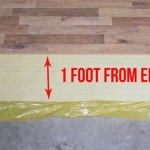Installing laminate flooring on concrete is a great way to update the look and feel of your home. Laminate flooring is an affordable, durable, and attractive option for many homeowners, and can be installed over concrete subfloors. While concrete is a durable and easy-to-maintain surface, it is important to follow the correct steps when installing laminate flooring on concrete.
Preparing the Subfloor
The first step in installing laminate flooring on concrete is to ensure the subfloor is level and clean. Any bumps, ridges, or unevenness must be smoothed out with a floor leveler. If the concrete is new, it must be allowed to cure for at least 60 days before installing the laminate. Any dust, dirt, or debris must be removed from the concrete before proceeding.
Installing an Underlayment
Once the subfloor is prepped and ready, it is time to install an underlayment. The underlayment serves two purposes: it provides a cushion between the laminate and the concrete, and it also helps protect the laminate from moisture. There are several types of underlayment available, including foam, cork, and rubber. When choosing an underlayment, make sure it is specifically designed for use with laminate flooring.
Installing the Laminate Flooring
Once the underlayment is in place, you can begin to install the laminate flooring. Laminate flooring typically comes in planks or tiles, and must be laid in a staggered pattern for the best look and stability. When installing the planks, make sure to use a tapping block and a rubber mallet to tap them into place. For tiles, use a rubber mallet to tap them into place.
Fitting Around Obstacles
When installing laminate flooring on concrete, it is likely that you will need to fit the planks or tiles around obstacles such as doorframes, pipes, or stairs. When doing this, make sure to use a jigsaw or other cutting tool to cut the planks to the correct size. Any gaps around the obstacles should be filled with a flexible silicone caulk.
Finishing Touches
Once all the planks or tiles are in place, it is time to finish the job. Start by trimming any excess material along the edges of the flooring. You can use a utility knife and a straight edge to do this. Once the edges are trimmed, you can apply a silicone sealant around the perimeter to protect the edges from moisture. Finally, you can install baseboards or other trim to give the floor a finished look.
Conclusion
Installing laminate flooring on concrete is a great way to update the look and feel of your home. With the right preparation and tools, you can tackle this project yourself and save money in the process. As long as you follow the steps outlined above, you should be able to install laminate flooring on your concrete subfloor with ease.




/laminate-flooring-underlayment-1314969-hero-3894e0b403fb4e59a87a076e3da9914f.jpg)










Related Posts








